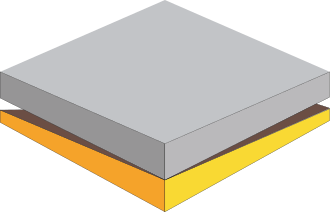OBP calculation for well¶
OBP calculation include the following step:
Extrapolate density log to the surface
Calculate Overburden Pressure
Calculate Hydrostatic Pressrue (*)
[2]:
from __future__ import print_function, division, unicode_literals
%matplotlib inline
import matplotlib.pyplot as plt
plt.style.use(['seaborn-paper', 'seaborn-whitegrid'])
plt.rcParams['font.sans-serif']=['SimHei']
plt.rcParams['axes.unicode_minus']=False
import numpy as np
import pygeopressure as ppp
1. Extrapolate density log to the surface¶
Create survey with the example survey CUG:
[18]:
# set to the directory on your computer
SURVEY_FOLDER = "M:/CUG_depth"
survey = ppp.Survey(SURVEY_FOLDER)
Retrieve well CUG1:
[4]:
well_cug1 = survey.wells['CUG1']
Get density log:
[5]:
den_log = well_cug1.get_log("Density")
View density log:
[6]:
fig_den, ax_den = plt.subplots()
ax_den.invert_yaxis()
den_log.plot(ax_den)
# set style
ax_den.set(ylim=(5000,0), aspect=(1.2/5000)*2)
fig_den.set_figheight(8)
fig_den.show()
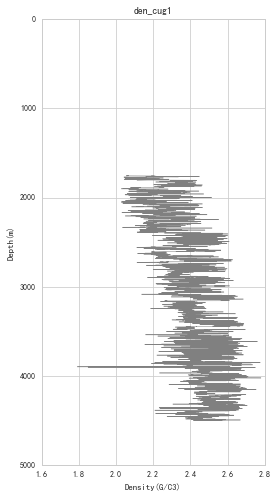
Find optimized coefficients for Traugott equation:
[7]:
a, b = ppp.optimize_traugott(
den_log, 2000, 3000, kb=well_cug1.kelly_bushing, wd=well_cug1.water_depth)
View fitted density trend:
[8]:
fig_den, ax_den = plt.subplots()
ax_den.invert_yaxis()
# draw density log
den_log.plot(ax_den, label='Density')
# draw fitted density trend line
den_trend = ppp.traugott_trend(
np.array(den_log.depth), a, b,
kb=well_cug1.kelly_bushing, wd=well_cug1.water_depth)
ax_den.plot(den_trend, den_log.depth,
color='r', linestyle='--', zorder=2, label='Trend')
# set style
ax_den.set(ylim=(5000,0), aspect=(1.2/5000)*2)
ax_den.legend()
fig_den.set_figheight(8)
fig_den.show()
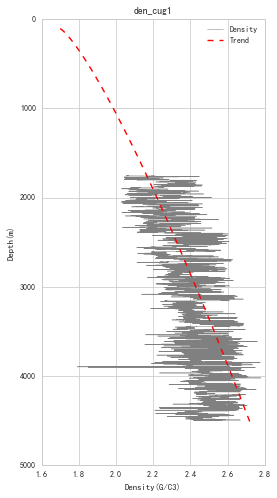
Since we will extrapolate density to mudline (sea bottom), density values of the inverval from mudline to kelly bushing will be NaN (See figure above).
Also, the actual variation of rock density underground doesnot have such high frequency as density logging data, so we need to perform some filtering and smoothing of the original signal.
Density log processing (filtering and smoothing):
[9]:
den_log_filter = ppp.upscale_log(den_log, freq=20)
den_log_filter_smooth = ppp.smooth_log(den_log_filter, window=1501)
View processed log data:
[10]:
fig_den, ax_den = plt.subplots()
ax_den.invert_yaxis()
# draw density log
den_log.plot(ax_den, label='Density')
# draw fitted density trend line
ax_den.plot(den_trend, den_log.depth,
color='r', linestyle='--', zorder=2, label='Trend')
# draw processed density log
ax_den.plot(den_log_filter_smooth.data, den_log_filter_smooth.depth,
color='g', zorder=3, label='Smoothed')
# set style
ax_den.set(ylim=(5000,0), aspect=(1.2/5000)*2)
ax_den.legend()
fig_den.set_figheight(8)
fig_den.show()
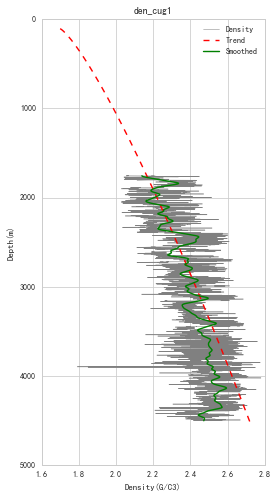
Extrapolate processed density log with fitted trend:
[11]:
extra_log = ppp.extrapolate_log_traugott(
den_log_filter_smooth, a, b,
kb=well_cug1.kelly_bushing, wd=well_cug1.water_depth)
View extraploted density log:
[12]:
fig_den, ax_den = plt.subplots()
ax_den.invert_yaxis()
# draw density log
den_log.plot(ax_den, label='Density')
# draw trend line
ax_den.plot(den_trend, den_log.depth,
color='r', linestyle='--', zorder=2, label='Trend')
# draw processed density log
ax_den.plot(den_log_filter_smooth.data, den_log_filter_smooth.depth,
color='g', zorder=3, label='Smoothed')
# draw extrapolated density
ax_den.plot(extra_log.data, extra_log.depth,
color='b', zorder=4, label='Extrapolated')
# set style
ax_den.set(ylim=(5000,0), aspect=(1.2/5000)*2)
fig_den.set_figheight(8)
fig_den.show()
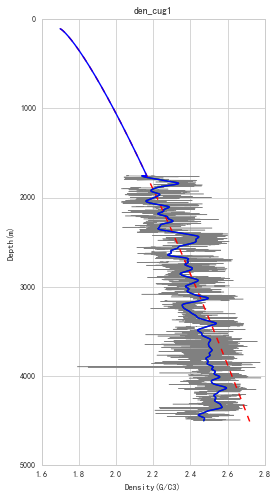
The extrapolated log (blue line in the figure above) is used for calculation of Overburden Pressure.
2. Calculation of Overburden Pressure¶
[13]:
obp_log = ppp.obp_well(extra_log,
kb=well_cug1.kelly_bushing, wd=well_cug1.water_depth,
rho_w=1.01)
* Calculation of Hydrostatic Pressure¶
Since parameters used for hydrostatic pressrue calcualtion like kelly busshing and water depth are store in Well, so we add a shortcut for hydrostatic pressure calculation in Well.
[14]:
# hydro_log = ppp.hydrostatic_well(
# obp_log.depth, kb=well_cug1.kelly_bushing, wd=well_cug1.water_depth,
# rho_f=1., rho_w=1.)
hydro_log = well_cug1.hydro_log()
View calcualted overburden pressure:
[15]:
fig_obp, ax_obp = plt.subplots()
ax_obp.invert_yaxis()
hydro_log.plot(ax_obp, color='g', linestyle='--', label='Hydrostatic')
obp_log.plot(ax_obp, color='b', label='OBP')
# set style
ax_obp.set(ylim=(5000,0), aspect=(100/5000)*2)
ax_obp.legend()
fig_obp.set_figheight(8)
fig_obp.show()
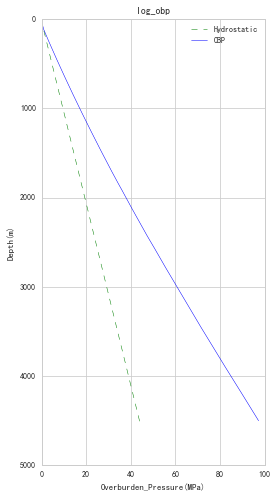
Save calculated Overburden Pressure:
[16]:
# well_cug1.add_log("Overbuden_Pressure")
optional, calculated overburden pressure has already been saved, so users don’t need to run these notebooks in specific order.
